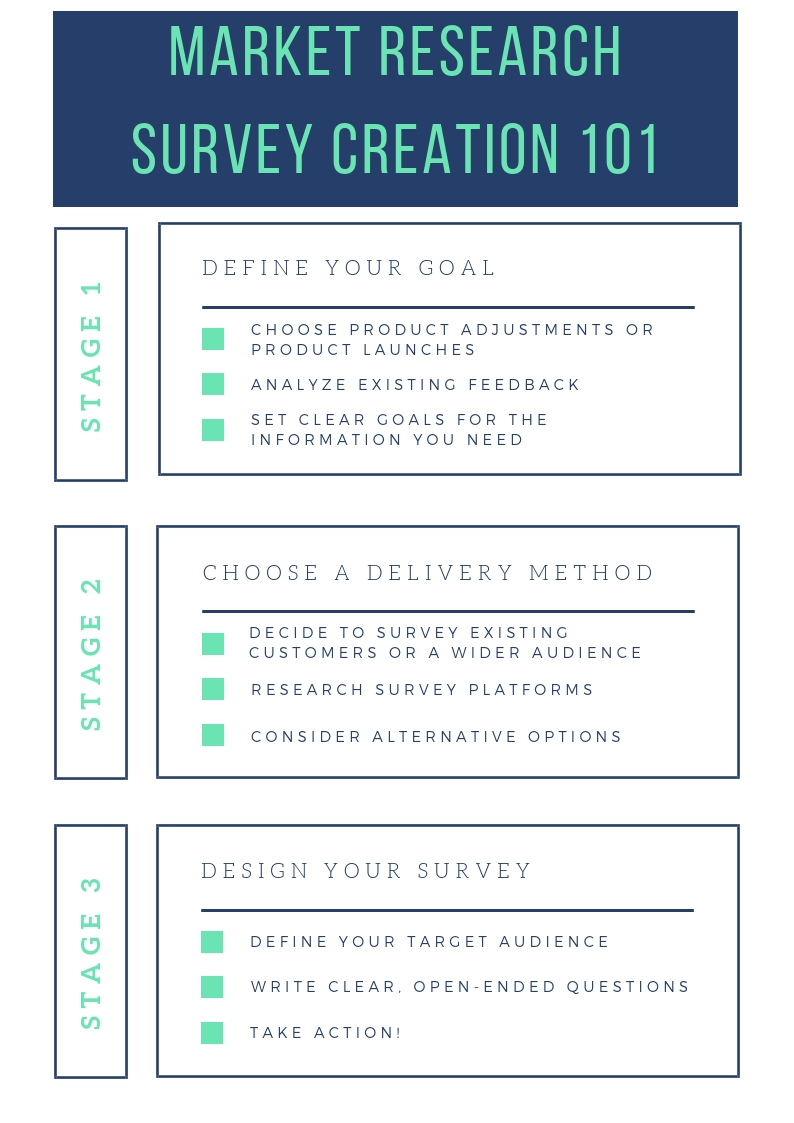The biggest names in business, from Lego to Apple, all have one thing in common: They constantly study their markets and look for ways to improve existing products and launch new, successful ones. Lego conducted a four-year study to develop toys that appealed to little girls. And, Apple utilized responses from Apple Customer Pulse (their ongoing survey program) and found that customers wanted bigger screens to watch videos and play games. Apple obliged.
Although your brand might not have its own theme park or a spaceship-style 2,800,000 square foot headquarters in Silicon Valley, these same survey methods can provide invaluable data to help improve your existing products and expand your lineup with new ideas.
To get the data you need, all you have to do is pinpoint what you want to know, decide which delivery method appeals to your base, choose your target and design your questions. Promise—it isn’t as time-consuming as it sounds, and the feedback you receive will help you grow your business and stay well ahead of the competition.
Quick note: For the purpose of brevity, “product” is used to describe tangible and intangible goods. These methods work whether you’re running a boutique on Etsy or offering consulting services to other businesses.

Defining what you’re looking for
Market research surveys differ from customer satisfaction surveys. But as with all surveys, you need to be focused and define what you’re looking for before you start crafting questions and deciding who to poll.
Improving products
Looking to tweak what you already offer? Start by digging through existing feedback to see what’s lacking. Reviews, social media comments and results from previous customer satisfaction surveys are all good starting points. Obviously, negative feedback will provide valuable data. However, look through positive feedback as well to see what customers love and brainstorm ways you might be able to build on those positives.
Your resulting survey should aim to reveal:
- What they love about a product
- What they dislike
- How the product could better serve them
Designing new products
Ready to expand your lineup? Review your existing feedback as discussed above. Specifically, what products are your biggest hits? How do customers use those products, and what new ideas tie into them? Likewise, which products have lackluster performances? Then, look at how you’re meeting customers’ needs and what they’re turning to competitors for to pinpoint places you could expand.
Your resulting survey should aim to reveal:
- What they need and are interested in seeing
- How they’re utilizing competitors’ products
- Which of your current ideas they’re most excited about
Choosing your delivery method
Obviously, there are multiple survey platforms and tools out there—a favorite among Biz.me readers is SurveyMonkey. If you need research from people who aren’t current customers, these products give you access to a wider audience. They’re also fantastic for surveys with defined timelines and a clear objective; e.g., when attempting to tweak a low-performing product or enhance a best-seller.
That said, if you need data from current customers and prospects, or only need to ask one or two questions, consider these ideas:
Add feedback forms to your site. This allows both current customers and prospects to share their thoughts.
Email surveys to customers shortly after a purchase. This is invaluable when you need input on your current products—their interaction with your brand is fresh and they’ll be more likely to provide feedback than if you waited a few months after the sale.
Call clients a few days after a project is complete and chat about their experience. Or, send a personalized email with the questions you want to ask.
Create polls on social media or ask followers’ open-ended questions. A quick Instagram or Facebook poll could provide insights into new products that would interest your base. If you’re fishing for ideas on updates or additions, and you have an engaged social media base, ask them directly what they’d like to see from you.
Designing your survey
Now that you have a goal, it’s time to decide who you’ll be surveying and what you need to ask them.
Targeting an audience
Sure, you can poll all of your existing customers to find ways to improve and expand your brand. But depending on your base, you might end up with a lot of data and no way to piece it together into actionable steps.
Want to improve your best-selling product? Target people who’ve used it recently.
Need to find out how to improve your product for specific demographics? Gear (and send) your survey to those specific groups.
Interested in pinpointing areas where improvements are needed? Target active customers.
Looking to see if your base is interested in a new idea? Survey customers who you think would be most interested in the new launch and/or your most active customers.
Attempting to improve a low-performing product? Poll people who’ve made one purchase yet never returned; those who’ve asked for refunds; or, people who’ve abandoned their cart.
Trying to find ideas for new products? Target active customers and consider sending the survey to demographics you think will be interested, yet who have never interacted with your brand.
Writing questions
Your list of questions—or the single question you decide to ask—depends on your specific brand and product lineup. Focus on your end goal and work backward to craft specific questions that will provide the data you need.
Keep these best practices in mind:
Don’t get too in the weeds. A survey should take 10 minutes or less to complete. That translates to approximately five to 10 open-ended questions or up to 30 multiple choice questions. Test your draft on friends and colleagues (using a timer) to make sure the survey isn’t too time-consuming.
Be as objective as possible. Leading questions, assuming an answer and implying an answer result in useless data. Push what you think you know about your base to the side and think of them as someone you respect and want to learn from. Asking “In what ways has this product improved your business?” implies that the product did, in fact, improve the customer’s business. Instead, try “Has this product improved your business? If so, what were the most noticeable improvements?”
Keep your language simple and clear. Once you have a rough draft, have people in your network, friends, family and employees read through the questions and give you feedback on what, if anything, made them pause or get confused.
Stick to open-ended questions (if possible). Rating scales and multiple-choice surveys can be useful, but they limit the respondents’ ability to speak their minds. If you want richer detail from your questions, add a comment box and encourage respondents to provide additional insights. Platforms like SurveyMonkey provide basic tools that help analyze responses to open-ended questions, and software packages like Nvivo can make them even easier to analyze and digest.
Depending on your base and research methods, you might have to provide a little nudge to get a solid number of responses. Tying the survey or feedback request to a giveaway, offering a small gift card or coupon to the first hundred or so responders or even sharing responses on social media encourage people to spill their thoughts.
Once you have your data, act on the feedback to the best of your ability and respond directly to customers as applicable to show you’re listening. And when your improved product rolls out, or you launch a new one, make sure you thank your base publicly to show that you’re just as engaged with them as they are with you.
Interested in even more ways to use customer feedback? Check out these Biz.me articles:



